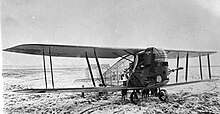
The Jumo 211 was a German inverted V-12 aircraft engine, Junkers Motoren's primary aircraft engine of World War II. It was the direct competitor to the Daimler-Benz DB 601 and closely paralleled its development. While the Daimler-Benz engine was mostly used in single-engined and twin-engined fighters, the Jumo engine was primarily used in bombers such as Junkers' own Ju 87 and Ju 88, and Heinkel's H-series examples of the Heinkel He 111 medium bomber. It was the most-produced German aero engine of the war, with almost 70,000 examples completed.
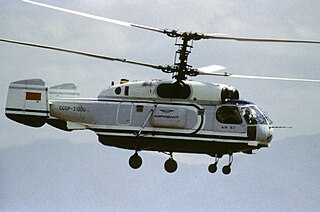
Contra-rotating, also referred to as coaxial contra-rotating, is a technique whereby parts of a mechanism rotate in opposite directions about a common axis, usually to minimise the effect of torque. Examples include some aircraft propellers, resulting in the maximum power of a single piston or turboprop engine to drive two propellers in opposite rotation. Contra-rotating propellers are also common in some marine transmission systems, in particular for large speed boats with planing hulls. Two propellers are arranged one behind the other, and power is transferred from the engine via planetary gear transmission. The configuration can also be used in helicopter designs termed coaxial rotors, where similar issues and principles of torque apply.
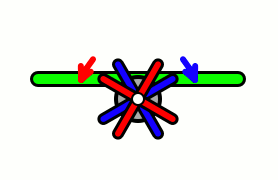
Aircraft equipped with contra-rotating propellers (CRP) coaxial contra-rotating propellers, or high-speed propellers, apply the maximum power of usually a single piston or turboprop engine to drive a pair of coaxial propellers in contra-rotation. Two propellers are arranged one behind the other, and power is transferred from the engine via a planetary gear or spur gear transmission. Contra-rotating propellers are also known as counter-rotating propellers, although the term counter-rotating propellers is much more widely used when referring to airscrews on separate non-coaxial shafts turning in opposite directions.

The Focke-Wulf Fw 191 was a prototype German bomber of World War II, as the Focke-Wulf firm's entry for the Bomber B advanced medium bomber design competition. Two versions were intended to be produced, a twin-engine version using the Junkers Jumo 222 engine and a four-engine variant which was to have used the smaller Daimler-Benz DB 605 engine. The project was eventually abandoned due to technical difficulties with the engines.

The BMW 803 was a German aircraft engine, an attempt by BMW to build a high-output aircraft engine by coupling two BMW 801 engines back-to-back, driving contra-rotating propellers. The result was a 28-cylinder, four-row radial engine, each comprising a multiple-bank in-line engine with two cylinders in each bank, which, due to cooling concerns, were liquid cooled.
The critical engine of a multi-engine fixed-wing aircraft is the engine that, in the event of failure, would most adversely affect the performance or handling abilities of an aircraft. On propeller aircraft, there is a difference in the remaining yawing moments after failure of the left or the right (outboard) engine when all propellers rotate in the same direction due to the P-factor. On turbojet and turbofan twin-engine aircraft, there usually is no difference between the yawing moments after failure of a left or right engine in no-wind condition.

The Daimler-Benz DB 603 was a German aircraft engine used during World War II. It was a liquid-cooled 12-cylinder inverted V12 enlargement of the 33.9 Liter DB 601, which was in itself a development of the DB 600. Production of the DB 603 commenced in May 1942, and with a 44.5 liter displacement figure, was the largest displacement inverted V12 aviation engine to be produced and used in front line aircraft of the Third Reich during World War II.
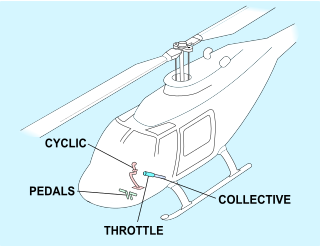
Helicopter flight controls are used to achieve and maintain controlled aerodynamic helicopter flight. Changes to the aircraft flight control system transmit mechanically to the rotor, producing aerodynamic effects on the rotor blades that make the helicopter move in a desired way. To tilt forward and back (pitch) or sideways (roll) requires that the controls alter the angle of attack of the main rotor blades cyclically during rotation, creating differing amounts of lift at different points in the cycle. To increase or decrease overall lift requires that the controls alter the angle of attack for all blades collectively by equal amounts at the same time, resulting in ascent, descent, acceleration and deceleration.

The tail rotor is a smaller rotor mounted vertically or near-vertically at the tail of a traditional single-rotor helicopter, where it rotates to generate a propeller-like horizontal thrust in the same direction as the main rotor's rotation. The tail rotor's position and distance from the helicopter's center of mass allow it to develop enough thrust leverage to counter the reactional torque exerted on the fuselage by the spinning of the main rotor. Without the tail rotor or other anti-torque mechanisms, the helicopter would be constantly spinning in the opposite direction of the main rotor when flying.
Blade pitch or simply pitch refers to the angle of a blade in a fluid. The term has applications in aeronautics, shipping, and other fields.

A coaxial-rotor aircraft is an aircraft whose rotors are mounted one above the other on concentric shafts, with the same axis of rotation, but turning in opposite directions (contra-rotating).

On a helicopter, the main rotor or rotor system is the combination of several rotary wings with a control system, that generates the aerodynamic lift force that supports the weight of the helicopter, and the thrust that counteracts aerodynamic drag in forward flight. Each main rotor is mounted on a vertical mast over the top of the helicopter, as opposed to a helicopter tail rotor, which connects through a combination of drive shaft(s) and gearboxes along the tail boom. The blade pitch is typically controlled by the pilot using the helicopter flight controls. Helicopters are one example of rotary-wing aircraft (rotorcraft). The name is derived from the Greek words helix, helik-, meaning spiral; and pteron meaning wing.
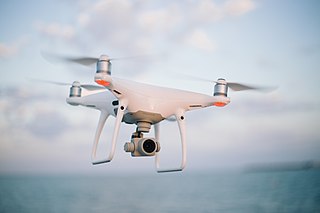
A quadcopter, also called quadrocopter, or quadrotor is a type of helicopter or multicopter that has four rotors.

A rotorcraft or rotary-wing aircraft is a heavier-than-air aircraft with rotary wings or rotor blades, which generate lift by rotating around a vertical mast. Several rotor blades mounted on a single mast are referred to as a rotor. The International Civil Aviation Organization (ICAO) defines a rotorcraft as "supported in flight by the reactions of the air on one or more rotors".

P-factor, also known as asymmetric blade effect and asymmetric disc effect, is an aerodynamic phenomenon experienced by a moving propeller, wherein the propeller's center of thrust moves off-center when the aircraft is at a high angle of attack. This shift in the location of the center of thrust will exert a yawing moment on the aircraft, causing it to yaw slightly to one side. A rudder input is required to counteract the yawing tendency.

The Messerschmitt Me 261 was a long-range reconnaissance aircraft designed in the late 1930s. It looked like an enlarged version of the Messerschmitt Bf 110. It was not put into production; just three Me 261s were built and used primarily for testing and development purposes.

In aeronautics, an aircraft propeller, also called an airscrew, converts rotary motion from an engine or other power source into a swirling slipstream which pushes the propeller forwards or backwards. It comprises a rotating power-driven hub, to which are attached several radial airfoil-section blades such that the whole assembly rotates about a longitudinal axis. The blade pitch may be fixed, manually variable to a few set positions, or of the automatically variable "constant-speed" type.
The torque effect experienced in helicopters and single propeller-powered aircraft is an example of Isaac Newton's third law of motion, that "for every action, there is an equal and opposite reaction."
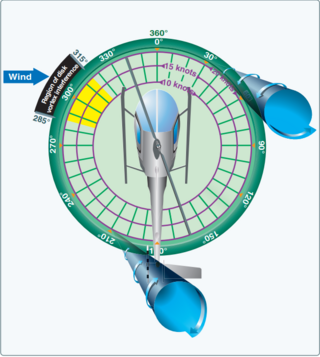
Loss of tail-rotor effectiveness (LTE) occurs when the tail rotor of a helicopter is exposed to wind forces that prevent it from carrying out its function—that of cancelling the torque of the engine and transmission. Any low-airspeed high-power environment provides an opportunity for it to occur.
Asymmetrical aircraft have left- and right-hand sides which are not exact mirror images of each other. Although most aircraft are symmetrical, there is no fundamental reason why they must be, and design goals can sometimes be best achieved with an asymmetrical aircraft.

